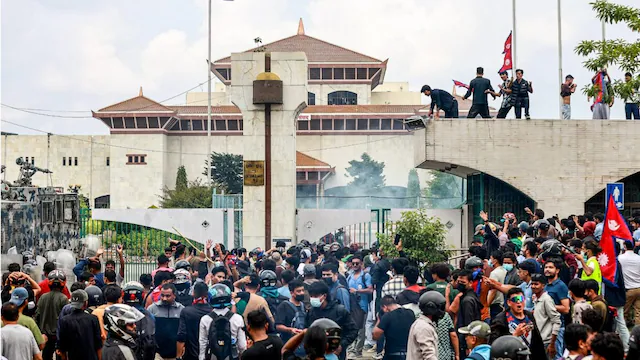Thousands of young Nepalis took to the streets of Kathmandu on Monday in a dramatic and deadly protest against the government’s sweeping ban on 26 popular social media platforms. The protest, largely spearheaded by Generation Z, escalated into violent clashes with police, resulting in at least nine deaths and over 42 injuries, according to Nepal Police.
In a statement, Nepal police said, “Nine people have lost their lives as the Protest turned violent in Kathmandu as people staged a massive protest against the ban on Facebook, Instagram, WhatsApp and other social media sites, leading to clashes between police and protesters.”
From Peaceful March to Chaos
The protests began peacefully around 9 AM in Maitighar, where demonstrators gathered waving national flags and singing the national anthem. Carrying placards with slogans like “Shut down corruption, not social media” and “Unban social media,” the crowd expressed widespread anger not just over the recent digital blackout but also decades of entrenched corruption, nepotism, and political favoritism.
Enough is Enough 🛑
Nepal’s Parliament under siege.
Thousands of Gen Z protesters gathered in Maitighar to protest against corruption and the government’s decision to silence free speech by banning social media apps. pic.twitter.com/so7U81azju
— iamikshahang 🧙 | 𝔽rAI (@ikshahangjabegu) September 8, 2025
Although the rally had received prior approval from the Kathmandu District Administration Office and was supported by civic group Hami Nepal, tensions escalated when protesters attempted to storm the Parliament premises. Police responded with water cannons, tear gas, rubber bullets, and later, live ammunition.
Deadly Violence in New Baneshwar
One of the worst confrontations occurred in New Baneshwar, where police opened fire on demonstrators who breached restricted zones. One protester succumbed to injuries while receiving treatment at Civil Hospital, and more fatalities were confirmed later in the evening. Several of the deceased have not yet been identified, authorities said.
Over 40 people sustained injuries and are being treated at Civil Hospital, Everest Hospital, and other medical centers. Hami Nepal also set up a first-aid camp at Maitighar for minor injuries.
💥 NEPAL
Looks like Bangladesh type Modus operandi: Youth protesting against the govt on roads, entering Parliament & creating chaos.
01 protester died, several injured.#BreakingNews #Nepalprotest #chaos pic.twitter.com/IoyBq9V6bL
— Mritunjay Kumar (@Mritunjayrocks) September 8, 2025


